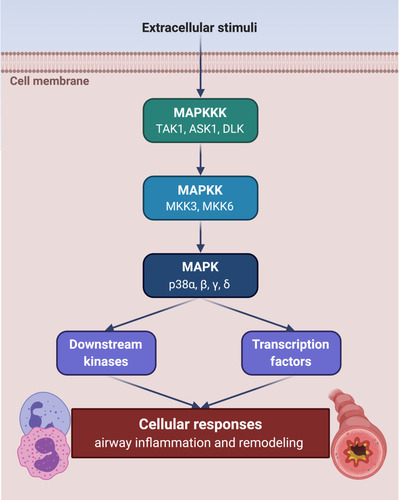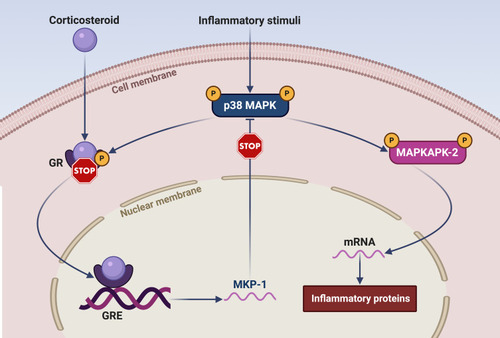Figures & data
Figure 1 Activation of p38 MAPK signalling module. p38 MAPK is activated through a kinase cascade triggered by extracellular inflammatory stimuli. This sequential phosphorylation pathway includes MAPK kinase kinases (MAPKKK) TAK1, ASK1 and DLK, whose targets are MAPK kinases (MAPKK) MKK3 and MKK6, which phosphorylate and activate the α, β, γ, and δ isoforms of p38 MAPK. The latter in turn phosphorylates downstream kinases and transcription factors involved in cellular responses underlying airway inflammation and remodelling. This original figure was created by the authors using BioRender.com.

Table 1 Summary of the Main Studies Evaluating P38 MAPK Inhibitors for Potential Treatment of COPD and Asthma
Figure 2 Cross-talk between corticosteroids and p38 MAPK. Acting at level of the glucocorticoid response elements (GRE) of target genes, corticosteroids induce the expression of MAP kinase phosphatase-1 (MKP-1), which dephosphorylates and inactivates p38 MAPK. In its active phosphorylated form, p38 in turn phosphorylates the glucocorticoid receptor (GR), thus impeding its nuclear translocation and the consequent biological and pharmacological actions of corticosteroids. In addition to inhibiting the anti-inflammatory effects of corticosteroids, p38 MAPK also plays a key proinflammatory role via phosphorylation-dependent activation of the downstream kinase MAPKAPK-2 (MAP kinase-activated protein kinase 2), which stabilizes several mRNAs encoding multiple cytokines and chemokines. This original figure was created by the authors using BioRender.com.

